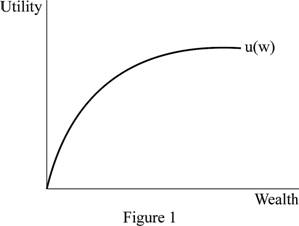
Sub part (a):
Diminishing marginal utility .
Sub part (a):
Explanation of Solution
The utility function is W12. Since the power function is less than one, the marginal utility will be diminishing. It implies that the person is risk averse.
Figure 1 illustrates the diminishing marginal utility.

In Figure 1, the horizontal axis measures the quantity of wealth and the vertical axis measures the utility. When the quantity of wealth increases then the additional utility decreases.
Concept introduction:
Marginal utility: Marginal utility refers to the additional units of satisfaction derived from one more additional unit of goods and services.
Diminishing marginal utility: Diminishing marginal utility refers to a decrease in the additional satisfaction as a result of increasing the consumption.
Sub Part (b):
Expected value.
Sub Part (b):
Explanation of Solution
Since the value is sure, the probability is 1. Expected value of A can be calculated as follows:
Expected value=Probability×Wealth=1×4,000,000=4,000,000
Expected value of A is $4,000,000.
Expected value of B can be calculated as follows.
Expected value=(Probability1×Wealth1)+(Probability2×Wealth2)=(0.6×1,000,000)+(0.4×9,000,000)=600,000+3,600,000=4,200,000
Expected value of B is $4,200,000. Thus, B offers higher value.
Concept introduction:
Risk is the future uncertainty about deviation from expected earnings or expected outcome. Risk measures the uncertainty situation that an investor is willing to take to realize a gain from an investment.
Risk aversion: Risk aversion can be defined as it is a dislike of an uncertainty.
Marginal utility: Marginal utility refers to the additional units of satisfaction derived from one more additional unit of goods and services.
Diminishing marginal utility: Diminishing marginal utility refers to a decrease in the additional satisfaction as a result of increasing the consumption.
Sub part (c):
Expected utility.
Sub part (c):
Explanation of Solution
Expected utility of A can be calculated as follows:
Expected value=Wealth12=4,000,00012=2,000
Expected utility of A is $2,000.
Expected utility of B can be calculated as follows.
Expected value=(Probability1×Wealth121)+(Probability2×Wealth122)=(0.6×1,000,00012)+(0.4×9,000,00012)=(0.6×1,000)+(0.4×3,000)=600+1,200=1,800
Expected utility of B is $1,800.
Concept introduction:
Risk is the future uncertainty about deviation from expected earnings or expected outcome. Risk measures the uncertainty situation that an investor is willing to take to realize a gain from an investment.
Risk aversion: Risk aversion can be defined as it is a dislike of an uncertainty.
Marginal utility: Marginal utility refers to the additional units of satisfaction derived from one more additional unit of goods and services.
Diminishing marginal utility: Diminishing marginal utility refers to a decrease in the additional satisfaction as a result of increasing the consumption.
Sub part (d):
greaterExpected utility.
Sub part (d):
Explanation of Solution
Since the expected utility from B is greater than A, the person should select A.
Concept introduction:
Risk is the future uncertainty about deviation from expected earnings or expected outcome. Risk measures the uncertainty situation that an investor is willing to take to realize a gain from an investment.
Risk aversion: Risk aversion can be defined as it is a dislike of an uncertainty.
Marginal utility: Marginal utility refers to the additional units of satisfaction derived from one more additional unit of goods and services.
Diminishing marginal utility: Diminishing marginal utility refers to a decrease in the additional satisfaction as a result of increasing the consumption.
Want to see more full solutions like this?
Chapter 27 Solutions
Principles of Economics (MindTap Course List)
- Price P 1. Explain the distinction between outputs and outcomes in social service delivery 2. Discuss the Rawlsian theory of justice and briefly comment on its relevance to the political economy of South Africa. [2] [7] 3. Redistributive expenditure can take the form of direct cash transfers (grants) and/or in- kind subsidies. With references to the graphs below, discuss the merits of these two transfer types in the presence and absence of a positive externality. [6] 9 Quantity (a) P, MC, MB MSB MPB+MEB MPB P-MC MEB Quantity (6) MCarrow_forwardDon't use ai to answer I will report you answerarrow_forwardIf 17 Ps are needed and no on-hand inventory exists fot any of thr items, how many Cs will be needed?arrow_forward
- Exercise 5Consider the demand and supply functions for the notebooks market.QD=10,000−100pQS=900pa. Make a table with the corresponding supply and demand schedule.b. Draw the corresponding graph.c. Is it possible to find the price and quantity of equilibrium with the graph method? d. Find the price and quantity of equilibrium by solving the system of equations.arrow_forward1. Consider the market supply curve which passes through the intercept and from which the marketequilibrium data is known, this is, the price and quantity of equilibrium PE=50 and QE=2000.a. Considering those two points, find the equation of the supply. b. Draw a graph for this equation. 2. Considering the previous supply line, determine if the following demand function corresponds to themarket demand equilibrium stated above. QD=.3000-2p.arrow_forwardSupply and demand functions show different relationship between the price and quantities suppliedand demanded. Explain the reason for that relation and provide one reference with your answer.arrow_forward
- 13:53 APP 簸洛瞭對照 Vo 56 5G 48% 48% atheva.cc/index/index/index.html The Most Trusted, Secure, Fast, Reliable Cryptocurrency Exchange Get started with the easiest and most secure platform to buy, sell, trade, and earn Cryptocurrency Balance:0.00 Recharge Withdraw Message About us BTC/USDT ETH/USDT EOS/USDT 83241.12 1841.50 83241.12 +1.00% +0.08% +1.00% Operating norms Symbol Latest price 24hFluctuation B BTC/USDT 83241.12 +1.00% ETH/USDT 1841.50 +0.08% B BTC/USD illı 83241.12 +1.00% Home Markets Trade Record Mine О <arrow_forwardThe production function of a firm is described by the following equation Q=10,000L-3L2 where Lstands for the units of labour.a) Draw a graph for this equation. Use the quantity produced in the y-axis, and the units of labour inthe x-axis. b) What is the maximum production level? c) How many units of labour are needed at that point?arrow_forwardDon't use ai to answer I will report you answerarrow_forward
 Essentials of Economics (MindTap Course List)EconomicsISBN:9781337091992Author:N. Gregory MankiwPublisher:Cengage Learning
Essentials of Economics (MindTap Course List)EconomicsISBN:9781337091992Author:N. Gregory MankiwPublisher:Cengage Learning Brief Principles of Macroeconomics (MindTap Cours...EconomicsISBN:9781337091985Author:N. Gregory MankiwPublisher:Cengage Learning
Brief Principles of Macroeconomics (MindTap Cours...EconomicsISBN:9781337091985Author:N. Gregory MankiwPublisher:Cengage Learning Managerial Economics: A Problem Solving ApproachEconomicsISBN:9781337106665Author:Luke M. Froeb, Brian T. McCann, Michael R. Ward, Mike ShorPublisher:Cengage Learning
Managerial Economics: A Problem Solving ApproachEconomicsISBN:9781337106665Author:Luke M. Froeb, Brian T. McCann, Michael R. Ward, Mike ShorPublisher:Cengage Learning Economics (MindTap Course List)EconomicsISBN:9781337617383Author:Roger A. ArnoldPublisher:Cengage Learning
Economics (MindTap Course List)EconomicsISBN:9781337617383Author:Roger A. ArnoldPublisher:Cengage Learning





